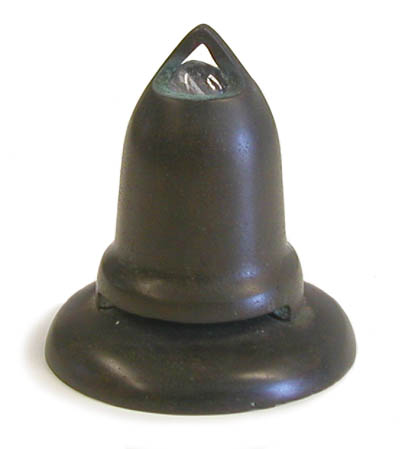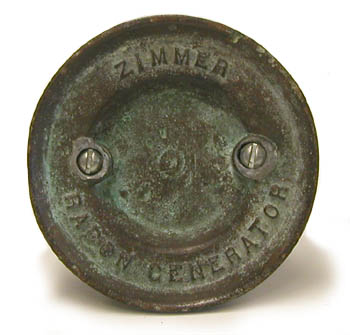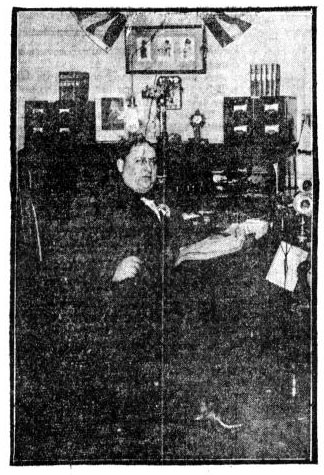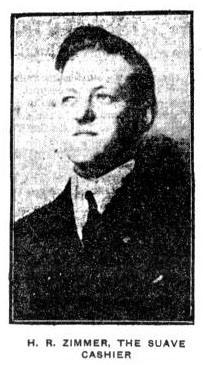Zimmer Radon Generator (ca. 1940)

Size: 3" high, 2 3/4" diameter at base
The Zimmer Radon Generator belongs to a category of devices called emanators. It would have been placed in water, usually 1-2 gallons, to infuse the water with radon, a radioactive gas.
The example shown above probably dates from the mid to late 1940s. An earlier version from the 1930s was named Zimmer Radium Emanator. As a rough estimate, the Zimmer Laboratories of Los Angeles (Bendix Building) produced 5,000 to 10,000 of these devices. If true, this would be remarkable since the device contained refined radium and cost U.S. $290 (plus tax).
The manufacturer acknowledged the "high cost of the element radium" but pointed out that "the Zimmer Radon Generator is the perfected product resulting from many years of highly technical research."

The radium activity in this device was too high for it to be put on display, so I removed the base (attached to the top with two bolts) and drilled out the source. The latter, which I crudely estimate at 0.05 mCi, was a small (ca. 1/2") cylinder suspended from the inside top of the emanator by a short rod. Note that this was done under the supervision of our Radiation Safety Officer—this is not something that should be attempted by a member of the public. In the process of drilling out the source, the small glass marble at the top of the emanator was cracked. The marble has a slight purple color as a result of its exposure to the radiation from the radium.
From the manufacturer's literature:
"The ZIMMER RADON GENERATOR IS the perfected product resulting from many years of highly technical research."
"Due to the "high Cost" of the element Radium, and the large amount that was necessary to produce, without controlling the explosion point of the EMANATIONS, even the small quantity of RADON equal to that found in the various radio-active Springs, made the cost almost prohibitive."
"A way had to be found to recover all, or the greater portion of the RADON. The ZIMMER RADON GENERATOR finally accomplished this vital achievement to a point whereby 90% of the exploding EMANATIONS are caused to occur within a short distance of the ZIMMER RADON GENERATOR, thereby producing in the water surrounding the Generator, the GREATEST POSSIBLE amount of RADON from given quantity of Radium EMANATIONS"
"Due to this perfection, the ZIMMER RADON GENERATOR is now produced at a comparatively nominal cost and is now available to the public. Over 6,000 have been placed throughout the world, and some have been in daily use for more than twenty years."
"The scientifically constructed ZINNER [sic] RADON GENERATOR contains its predetermined [sic] quantity of PURE REFINED RADIUM, (Not Radium Salts.) and will last indefinitely, producing the stated quantity of RADON in the water surrounding it."
From the Danville Virginia Bee (Oct. 2, 1928):
"Declaring that radium will add fifteen years to anybody's life, Capt. H.R. Zimmer, Los Angeles inventor who has been experimenting with radium for twenty-nine years, today described in an interview a device he has perfected [presumably an early version of the Zimmer generator] that makes ordinary drinking water "radio active" with amazing results. Radioactive water makes old men feel young—"peps em up," said Zimmer. "It's not a cure-all but it does remarkable things. It tones up the system, reduces high blood pressure, and softens harding [sic] arteries"... Zimmer, who is 64, said he doesn't feel a day over 44. He has the appearance and vigor of a man of middle age. He is in New York in connection with tests he has invented and which is known as "radium-atomite," said to be more powerful than TNT. He has sixty-one inventions to his credit."
Learn more about another emanator that Zimmer was involved with.
Harry Raymond Zimmer’s Questionable Birth
Harry Raymond Zimmer was born March 20, 1877 in Neponset, Illinois. That’s a best guess.
The problem is that he reported multiple birthdates. As a rule, he tended to claim in his press interviews that he was about 13 years older than he indicated on most (not all) of his official records. Case in point: an article in the September 12, 1941 issue of the Alpine Avalanche noted that Zimmer
“looks to be perhaps 60 years of age but confesses to 78” “I arrived in the United States in time for the Civil War,” he said. “in other words, I was born in 1863.”
Interesting. His draft registration card stated that he was born March 20, 1877, his California County marriage record estimated his birth year as 1877, and the 1940 U.S. census estimated that he was born in 1876. On the other hand, the State of California death index for 1956 gives his birth date as March 23, 1862, reasonably consistent with what he claimed in the 1941 interview. He was born around 1862/1863 or he was born around 1876/1877. At one point or another, he must have misled people concerning his age. Okay, he lied.
An Impressive Resume
The following is a partial summary of Zimmer’s claims and businesses.
Zimmer stated in the aforementioned article from 1941 in the Alpine Avalanche that he was the chief electrician at the 1893 Chicago World’s Fair. Wow! The fair was a showcase for the Westinghouse Company who provided the illumination using their alternating current system. Westinghouse had underbid General Electric for the contract - GE proposed to use direct current. Had Zimmer been born in 1877, he would have been 16 years old when the Fair took place. Claiming to be born in 1863 is more consistent for someone given such a responsible position.
In the same interview, Zimmer indicated that he was the first man to cross the United States in an automobile:
“gas buggy from New York to Los Angeles... the time required was 27 days.”
Zimmer also claimed to be a motion picture maker, the inventor of what might have been the first motion picture camera in the U.S., and the cinematographer for “Birth of a Nation.” According to his interview in the October 6, 1921 issue of the Arizona Republican. Zimmer was involved with a film processing facility that had just been constructed in Phoenix, and the newspaper was seeking information about it. The relevant parts of the article follow:
“Captain H. R. Zimmer, a veteran motion picture maker, who is associated with Arizona Motion Pictures, Inc., for which the laboratory will be used as well as for commercial work, estimates its value at approximately $14,000.”
“Zimmer, who built the improved printer for the local enterprise, devised what he believes was the first motion picture camera made in this country, in Chicago, in 1891. This machine and its film were greatly similar to those in use today, he said yesterday. His only regret is that motion pictures did not become common until after his patents had run out, as his royalties did not more than pay for his experimental work. Zimmer served in the Spanish-American war and in the world war, during the latter taking movies of the actual fighting for the war department. He has been active in the motion picture industry for the last two decades, and did much of the intricate photography for "The Birth of a Nation." "Intolerance," and Hearts of the World."
“Zimmer announced yesterday that he company [Arizona Motion Pictures, Inc.] will continue making pictures, financing arrangements having been completed. The company includes a number of well-known local men [aka “dupes”] among the directors.”
He invented the Zimmer centrifugal separator for refining gold and silver ore which he appears to have marketed to mining companies in 1916. (Mohave County Miner, August 19, 1916).
He worked for three years with Thomas Edison in New Jersey (Mohave County Miner., August 19, 1916).
He owned a cattle ranch in Texas (Mohave County Miner, August 19, 1916).
Captain or Major?
He certainly liked the title Captain Zimmer, but I have found nothing (other than his statements) to substantiate that he ever served in the military. Then again, there is the following report in the August 11, 1915 issue of the Arizona Republican:
“Captain H.R. Zimmer who is connected with the engineering corps of the U.S. Army who has been on detached service for some time past, has been promoted to the rank of major.”
It is safe to assume that Zimmer provided the information to the newspaper. Odd that he continued to identify himself as Captain Zimmer. Perhaps he forgot the promotion.
According to Zimmer, he had been in charge of a signal corps company during the Spanish-American war (LA Herald, Apr. 29, 1918). Elsewhere it is stated that he founded the signal corps and was wounded in the battle of San Juan Hill.
Minor Scrapes with the Authorities
The authorities (aka “the man”) seemed to have been after him.
The first incident that I can document occurred in 1907. According to the October 19, 1907 issue of the Los Angeles Herald, Zimmer
“was charged with employing a boy of 14 years to work for him” in violation of the child labor laws.
Another run-in with the law took place in 1921 when he was in Sierra Anchas, Arizona, possibly to visit the famous Salado indian ruins. This time Zimmer was arrested for defrauding an innkeeper out of $300. Ruined his day, I’m sure (Miami Daily Arizona Silver Belt, Aug. 11, 1921).Arizona’s Allure
If he wasn’t in California (usually LA), Zimmer was in Arizona (usually Phoenix). It was there that he was arrested for fraud. It was in Arizona that he promoted his Zimmer Centrifugal Separator. He sought financing for his movie production business in Arizona. His second and third wives were born in Arizona. And as we will explain later, it was in Arizona that he searched for a missing “dead woman.”
Mr. and Mrs. Zimmer
In 1905, he married Beulah Kizia Smith. Beulah was born in 1877 in Perntown, Ohio. I am not sure how long the marriage lasted before they divorced, but it was in less than ten years.
In August of 1915, Harry married Lydia Stewart from Mesa, Arizona. She was 22, he was probably 38 but the marriage record indicated that he was 48 (b. 1867). They had one child, a daughter. Lyda Rae Zimmer was born in August of 1916. It wasn’t long before Lydia filed for divorce. The marriage lasted less than three years.
Testimony that Harry had been residing in a hotel with another woman, referred to during the court proceedings as “Jane Doe,” was considered sufficient grounds for Lydia to be granted a divorce from her “mining engineer” husband in April 1918. Lydia was awarded $100 a month as alimony and child support.
Harry wasted no time in marrying the “other woman.” Indita Christie (nee Bennessee) and Harry were hitched June 16, 1919 in Los Angeles. According to the marriage certificate, he was 52 (estimated to be born 1867) and she was 29. Indita was from Arizona.
Six months later, in March of 1920, Harry and his “attractive wife” parted ways. The headline in the LA Herald (March 3, 1920) read “Snake Charmer is Granted Divorce.”
Indita, said to be an indian princess, the daughter of Chief Sheet Lightning, was well-known on the vaudeville circuit for her dance routine that included snakes. Seems she might have entertained them at home as well. The charges in the divorce, from both sides, were cruelty and mental suffering.
“What did you see in this man that you should want to marry him."
Judge Jackson asked Mrs. Zimmer.
“I don’t know, judge, I guess I was crazy.”
Still, her six-month marriage to Harry was more successful than her first. Harry’s lawyer raised the issue by asking her “if she did not marry a man on his deathbed.” “She explained that she did marry a childhood sweetheart who died two hours after the ceremony.”
Strangely enough, Harry and Beulah (now Beulah K. Nofte) decided to give it another try. They were married for a second time in August of 1927, in Oregon. This time they stayed married. According the 1940 U.S. Census, Harry and Beulah were living together in Los Angeles along with her sister Flora.
Zimmer Discovers Radium in 1927
Zimmer didn’t dispute Marie Curie’s claim of priority. Although he was the kind of guy who might have done so. In 1927 he filed a patent for his Radium Emanator. This is the earliest indication I have found that he was on the radioactive bandwagon.
If a newspaper article from 1928 is to believed, he began studying radium in 1899:
"Capt. H.R. Zimmer... has been experimenting with radium for twenty-nine years, today” (Danville Virginia Bee, October 2, 1928).
As Mac Rebennack would say, Zimmer was in the right place at the wrong time. Los Angeles was the birthplace in the U.S. for radioactive quack cures. For example, the Radium Appliance Company had been operating for a decade or so and another California company was selling hundreds of thousands of Revigators, jars lined with radium ore. If nothing else, Harry could recognize a money making opportunity when he saw one. The catch was that the halcyon days for radium-containing nostrums were coming to an end. The deaths of the radium dial painters had just become the basis for a highly publicized lawsuit, the Great Depression was around the corner, and the Federal Trade Commission was starting to clamp down on people like Zimmer.
Of course, the ultimate expression of his faith in radium is the device at the top of this page, the Zimmer Radon Generator, aka the Zimmer Radium Emanator. Despite the problematic timing for bringing such a product to market, it was amazingly long-lived. His Zimmer Laboratories operation began selling them in 1928 and they continued to be sold until 1950 or so. Of course a product that “adds fifteen years to life” (Danville Bee, Oct. 2, 1928) was bound to do well. Then again, altering your birthdate would accomplish the same thing.
The same year that his emanator hit the market (1928), Zimmer received substantial press coverage for another radioactive invention: Radium-Atomite, an explosive supposedly fifty times as powerful as nitro-glycerin. Demonstrations of its explosive power at the California Institute of Technology were covered in the August and September issues of Popular Science. Although Zimmer refused to allow CalTech’s chemists to analyze Radium-Atomite (the War Department might have wanted to keep its composition a secret) he acknowledged that radium was a key ingredient. A similar explosive using his Z R B formula was supposedly employed during the first world war in depth bombs.
To my knowledge, Zimmer never published in the scientific literature. Nevertheless, his expertise was such that he was called as a witness in the lawsuit brought by radium dial painters. This would also have been 1928. To be clear, we only have Zimmer’s claim to have been a witness in the case. The following quote concerning his supposed testimony is from the September 12, 1941 issue of the Alpine Avalanche:
“Captain Zimmer said. “I was able to swear that radium is not a poison, and does not cause burns... Radium is harmless in those respects. It is the zinc alloy that does the harm, as well as give the glow [i.e., the zinc sulphide luminous material in the paint].
One of the most intriguing of Zimmer’s radium projects was the breath analysis he conducted on radium workers in 1928. Intriguing, because this was a very early use of this methodology. Later on, especially during the 1940s, it became a standard technique employed by, among others, Victor Hess at Fordham University and Robley Evans at MIT. The method uses the concentration of radon in the breath to estimate the activity of radium in the body. Quoting from the October 1928 issue of Popular Science:
“Captain H. R. Zimmer, Los Angeles chemist... demonstrates his device to protect luminous watch dial makers from radium poisoning. It takes and tests specimens of their breath to see if they are affected by the radium used in manufacturing the dials.”
A remarkable press photograph, possibly unpublished, shows Zimmer collecting a breath sample from a worker at Pacific Radium Appliance Company in Los Angeles. A flask for drying the exhaled air, and a Lind electroscope for quantifying the radon are clearly visible. I have trouble saying this, but the setup looks legit! The text on the back of the photograph refers to Zimmer as a “famous radium products technician” and that the “new testing device... is said to be the only apparatus in existence of its kind.
The Suave Cashier and 300% Brown
Sometime around noon, March 15, 1909, Los Angeles investment broker and ex-convict, Harry D. Brown, suddenly disappeared. Under investigation by the police for what the Los Angeles Herald called a get-rich-quick scheme, Harry knew when it was time to make an exit.
Left holding the bag for over a quarter of a million dollars were the too-trusting clients to whom Brown had promised investment returns of 300%. Hence his nick-name in the Herald, “300% Brown.”

Harry D. Brown
“one of the cleverest operators that ever worked a confidence game" (Los Angeles Herald, Oct. 17, 1907)
Brown’s right hand man, you guessed it, was Harry R. Zimmer. Described condescendingly by the Herald as the “suave cashier,” Zimmer maintained his faith in Brown but “was very bitter in his remarks regarding the newspapers which have printed stories exposing the fraudulent game operated by his friend and employer.”
Harry R. Zimmer
When asked by the paper how it was possible to produce the 300% plus returns they promised to their clients,
“Zimmer said that that It was done by "scalping the New York market." He said the lambs of Wall street were furnishing the fleece for the Los Angeles shears.”
"Police were highly skeptical of “the trusted clerk and confidential secretary of "300 per cent" Brown, who says he lost approximately $20,000 by placing his trust in Brown's ability to trim the magnates of Wall Street.”
According to the Herald, Zimmer’s claims of financial losses were taken by police with “several large sprinklings of salt.”
"[Zimmer] stated that 45 cents was all the material wealth he had left at that time, and he said that, in order to provide for himself and wife temporarily, his wife [Beulah] pawned her jewelry, on which she realized $35.”
Soon afterwards, as Zimmer ruefully complained, his house was broken into and the $35 dollars taken. Had the anger that the creditors felt caused them to seek compensation from an innocent man, he had nothing left to take.
Creditors crowded in the small company office in the Union Trust Building. Upon hearing a story from one of those present how she had been bilked, Zimmer murmured "Yes... we all lost," and he drew his handkerchief from his pocket and wiped his eyes.”
Undoubtedly the idea was to demonstrate solidarity with Brown’s creditors. On Thursday (March 18) Zimmer had a bed placed in the office and announced that he would stay there until Brown returned. Prepared for trouble during his vigil, Zimmer armed himself with a pistol and handcuffs. You never knew who might break into the office searching for hidden loot.
The very next day, Brown was located in Tijuana. According to those who found him, he was enjoying the company of two other fugitives, "Nick" Oswald and William Lawrence.
The following Monday (March 22) Zimmer outlined a plan to go to Tijuana in pursuit of Brown in the hope that he could induce him to return to LA and face his creditors.
Thursday, the day after he was supposed to leave, Zimmer told the Los Angeles Herald that he wasn’t leaving after all. The Herald explained:
“Instead of hunting Brown, Zimmer states that he is going back to his old vocation and will establish a detective agency in Los Angeles.”
Detective Zimmer and the Barrett Murder Case
This case is nicely chronicled by Joan Renner as the “Santa Monica Cesspool Slayings” in her Deranged LA Crimes blog. If you want the complete story, read it. I won’t tell you.
The following comment of hers explains a great deal:
“A case as bizarre and highly publicized as Barrett’s attracts every nutcase for miles.”
She must have been referring to the “assorted wackos” like the dowser and the astrologer.
The accused in the 1916 murder case was Benton H. Barrett, a man of highly suspect mental competence. He had confessed to murdering his wife Irene (20 years his junior) and his stepson because he believed were plotting to kill him in order to inherit his estate. Key parts of his confession held up, e.g., portions of a skeleton were found where Barrett indicated that he had disposed of the bodies. However, there were many discrepancies in his confused testimony, and the discovered remains were not consistent with two people having been murdered in the manner that he had described.
The chief investigator for the prosecution was the well-known Malcolm McLaren. The lead investigator for the defense? H. R. Zimmer, of course. In some press accounts, the trial was played up as a “battle of wits between two detectives” described as “rival students of criminology.” Playing up his credentials, the Los Angeles Herald stated “In Chicago Zimmer worked on the famous Luetgert murder mystery.” For more details about the Luetgert case, perform a web-based search for “sausage vat murder.” Oddly enough, none of results will say anything about Zimmer’s role.
In Deranged LA Crimes, Renner described how
“Barrett’s defense attorney, Lewis D. Collings, and Capt. H.L. Zimmer... didn’t believe the man’s confession for one minute. According to Collings and Zimmer there were several people, principally his wife Irene, who had schemed to pray [sic] on Barrett’s weakened mind for the sole purpose of profit.”
As it turns out, Zimmer’s theory was spot on. Barrett was found innocent, and H.R. Zimmer deserves some of the credit.
After the trial, Zimmer told the press that he would not rest until Irene, whom he was certain was still alive, was brought to justice. Documenting the search, an article headlined “Hunting for a Dead Woman,” in the December 30, 1916 issue of the El Paso Herald reported how Irene had been tracked down by
“H. R. Zimmer, former chief of Los Angeles detectives. He is said to have been trailing her for three months.”
Zimmer’s investigations led him to Phoenix, Arizona, a town he knew well. Especially when it came to finding women.
The End
Harry R. Zimmer died June 21, 1956, in Los Angeles. He would have been 79 (or 93).
Donated by the Oregon Radiation Control Section, courtesy of Martha Dibblee.
Reference
Booklet used by a distributor of the Zimmer Generator. The booklet contains analyses, testimonials etc., that would be useful when selling the product. Probably late 1940s based on testimonial letters dated 1947.
